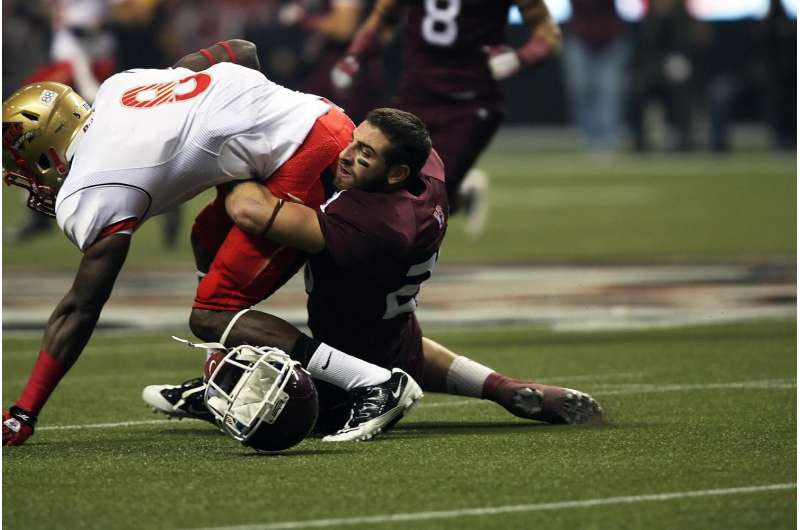
Vanderbilt University Medical Center researchers examined whether race (Black or White) influences outcomes and subjective experiences in young athletes who have sustained a sports-related concussion. Of primary interest were how long it takes for symptom resolution and return to school as well as changes in daily activities and sports behaviors. Findings of the study can be found in the article “Exploring the outcomes and experiences of Black and White athletes following a sport-related concussion: a retrospective cohort study” by Aaron M. Yengo-Kahn, MD, and colleagues, published today in the Journal of Neurosurgery: Pediatrics.
The study was performed with the aid of the Vanderbilt Sports Concussion Registry. The researchers focused on 36 Black and 211 White young athletes (12 to 23 years of age) who sustained a sports-related concussion and were treated between 2012 and 2015. Data were collected via a review of medical records and telephone communications with the athletes and their parents or guardians.
Race was determined on the basis of self-identification by the study participants. Standardized phone interviews were used to elicit information on the young athletes’ outcomes and subjective experiences following the concussion. Patient demographics, family financial status (based on zip code–defined median incomes), and health insurance status were also collected. The data collected were cross-validated with information in patients’ electronic health records; discrepancies were resolved by additional phone contacts. The data were examined using descriptive analyses, multivariable Cox proportional hazards models, and logistic regression.
Four primary outcomes consisted of the number of days between injury and both symptom resolution and return to school, and whether the participants stated that they had experienced post-injury changes in daily activities and/or sports behavior.
If patients noted post-injury changes in daily activities, they were asked more specific questions about whether they had experienced changes in time spent studying for school, watching television, playing video games, and sleeping. If patients noted post-injury changes in sports behavior, they were asked additional questions including whether they had stopped playing the sport in which they had received the concussion, made different choices in wearing protective equipment, and/or changed their style of play (for example, became more or less reckless).
All athletes were enrolled in school (middle school, high school, or college). Fifty-eight percent of White athletes were male, as were 78% of Black athletes. The age distribution within both groups of athletes was similar, and the groups’ past medical and family histories were comparable. More White athletes had private insurance than Black athletes (94% vs. 67%), and more White athletes lived in higher income neighborhoods.
Black athletes reported a shorter time between injury and symptom resolution than White athletes (median 12.3 days [interquartile range {IQR} 6.8–28.0 days] vs. 21.0 days [IQR 10.5–61.0 days]). Black athletes also reported a shorter time away from school (median 0 school days [IQR 0–2 school days] vs. 2 school days [IQR 0–5 school days] before returning to school). In both situations, the differences between the races held true when the researchers adjusted for age, sex, concussion history, median income, and health insurance type.
With respect to changes in daily activities, White athletes reported spending less time sleeping, watching television, and doing homework than Black athletes following the concussion. After the researchers controlled for age, sex, concussion history, median income, and health insurance type, they found that Black athletes had lower odds of reporting a change in daily activities post-injury.
Black athletes reported making a change in protective equipment more often than White athletes (25.0% vs. 12.3%), but, overall, changes in sports behavior did not differ between the two groups.
The researchers discuss a variety of factors that might be associated with the racial differences identified in young athletes with respect to concussion symptom resolution, return to school, and post-concussion changes in daily activities. However, these factors have not been thoroughly studied. The researchers encourage initiation of new studies focusing on the mechanisms and root causes behind these racial differences related to outcomes and experience of sports-related concussion. In closing their article, the authors state, “Understanding the mechanisms of these differences is important for providing effective management strategies and reinforces the necessity of diverse study cohorts going forward.”
When asked about the findings of the study, Dr. Yengo-Kahn, responded, “Across medicine race has been shown to be a social construct and determinant of health; and health outcomes can vary dramatically with regard to race. Despite prior evidence of health inequities across races in neurosurgery and medicine in general, there were disproportionately few studies exploring racial differences with regard to sports-related concussion. This was troubling to us as the student-athlete population, those at risk for sports-related concussion, is so racially and culturally diverse. Our findings suggest racial differences in recovery time, but we must strive to better understand the driving factors and whether these findings are downstream consequences of care access, concussion education resource access, or school-based provider access (i.e. athletic trainers, team doctors). We are currently analyzing care access pathways and a more in-depth analysis of race and clinical recovery to better understand the findings discussed in this article. Regardless of the root cause of these differences, we hope these findings encourage concussion researchers to consistently report the racial and ethnic make-up of their study populations to maximize the utility in the diverse student athlete population.”
Source: Read Full Article
